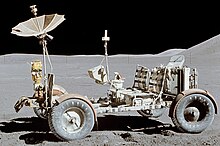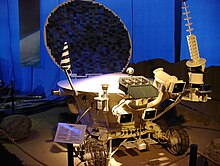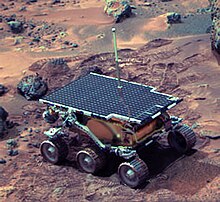Rover (space exploration)

A rover is a space exploration vehicle designed to move across the surface of a planet or other astronomical body. Some rovers have been designed to transport members of a human spaceflight crew; others have been partially or fully autonomous robots. Rovers usually arrive at the planetary surface on a lander-style spacecraft.
History
Lunokhod 1
The Lunokhod 1 rover landed on the Moon in November 1970.[1] It was the first roving remote-controlled robot to land on any celestial body. The Soviet Union launched Lunokhod 1 aboard the Luna 17 spacecraft on November 10, 1970, and it entered lunar orbit on November 15. The spacecraft soft-landed in the Sea of Rains region on November 17. The lander had dual ramps from which Lunokhod 1 could descend to the lunar surface, which it did at 06:28 UT. From November 17, 1970 to November 22, 1970 the rover drove 197 m, and during 10 communication sessions returned 14 close up pictures of the Moon and 12 panoramic views. It also analyzed the lunar soil. The last successful communications session with Lunokhod 1 was on September 14, 1971. Having worked for 11 months,[2] Lunokhod 1 held the durability record for space rovers for more than 30 years, until a new record was set by the Mars Exploration Rovers.
Apollo Lunar Roving Vehicle

NASA included Lunar Roving Vehicles in three Apollo missions: Apollo 15 (which landed on the Moon July 30, 1971), Apollo 16 (which landed April 21, 1972) and Apollo 17 (which landed December 11, 1972).[3]
Lunokhod 2

The Lunokhod 2 was the second of two unmanned lunar rovers landed on the Moon by the Soviet Union as part of the Lunokhod program. The rover became operational on the Moon on 16 January 1973.[4] It was the second roving remote-controlled robot to land on any celestial body. The Soviet Union launched Lunokhod 2 aboard the Luna 21 spacecraft on January 8, 1973, and it entered lunar orbit on January 12. The spacecraft soft-landed in the eastern edge of the Mare Serenitatis region on January 15. Lunokhod 2 descended from the lander's dual ramps to the lunar surface at 01:14 UT on 16 January. Lunokhod 2 operated for about 4 months, covered 37 km (23 miles) of terrain sending back 86 panoramic images and over 80,000 TV pictures. It also analyzed the lunar soil.
Prop-M Rover
Mars 3 lander had a small 4.5 kg Mars rover on board, which would move across the surface on skis while connected to the lander with a 15-meter umbilical. Two small metal rods were used for autonomous obstacle avoidance, as radio signals from Earth would take too long to drive the rovers using remote control. The rover was planned to be placed on the surface after landing by a manipulator arm and to move in the field of view of the television cameras and stop to make measurements every 1.5 meters. The traces of movement in the Martian soil would also be recorded to determine material properties. Because of the demise of the lander, the rover never saw action.
Sojourner

The Mars Pathfinder mission included Sojourner, the first rover to successfully reach another planet. NASA, the space agency of the United States, launched Mars Pathfinder on 1996-12-04; it landed on Mars in a region called Chryse Planitia on 1997-07-04.[5] From its landing until the final data transmission on 1997-09-27, Mars Pathfinder returned 16,500 images from the lander and 550 images from Sojourner, as well as data from more than 15 chemical analyses of rocks and soil and extensive data on winds and other weather factors.[5]
Active rover missions

Mars Exploration Rovers
Two rovers, Spirit and Opportunity, were landed on Mars as part of the Mars Exploration Rover mission. Both Spirit and Opportunity have been operating on Mars since January 2004. By March 19, 2009, Opportunity had traversed 15 kilometers on the Martian surface.[6]
Planned rover missions

Mars Science Laboratory
The Mars Science Laboratory is a NASA rover scheduled to launch in the fall of 2011.[7][8] The MSL rover will be over five times as heavy and carry over ten times the weight in scientific instruments as one of the Mars Exploration Rovers.[9]
Chandrayaan-II
The Chandrayaan-II mission is a joint venture between India and Russia, consisting of a lunar orbiter and a lunar lander. An opportunity was given to students to design this rover. 150 students gave their designs but only 6 were selected. They gave a demonstration in NRSA and are going to ISRO.
Future lunar missions
NASA's plans for future moon missions call for rovers that have a far longer range than the Apollo rovers.[10]
Autonomy
Distances and lag times
Rovers which land on celestial bodies far from the Earth - such as the Mars Exploration Rovers - cannot be remotely controlled in real-time since the the speed at which radio signals travel is far too slow for real time or near-real time communication. These rovers are thus capable of operating autonomously with little assistance from ground control.
References
This article needs additional citations for verification. (January 2008) |
- ^ "Lunar Lost & Found: The Search for Old Spacecraft". www.space.com/. Retrieved 2009-03-18.
- ^ "Luna 17 and Lunokhod 1". www.zarya.info/. Retrieved 2009-08-23.
- ^ "Experiment: Lunar Rover Vehicle". Ares.jsc.nasa.gov. Retrieved 2009-03-18.
- ^ "Luna 21 and Lunokhod 2". www.zarya.info/. Retrieved 2009-08-23.
- ^ a b "Mars Pathfinder". NASA. Retrieved 2009-03-18.
- ^ "At Outcrop with Endeavour in Sight". NASA/JPL. 2009-03-19. Retrieved 2009-03-23.
- ^ "Next NASA Mars Mission Rescheduled For 2011". NASA/JPL. 2008-12-04. Retrieved 2009-03-18.
- ^ "NASA's Shuttle and Rocket Missions". NASA. Retrieved 2009-03-18.
- ^ "Troubles parallel ambitions in NASA Mars project". USA Today. 2008-04-14. Retrieved 2009-03-18.
- ^ http://www.nasa.gov/exploration/home/LER.html
